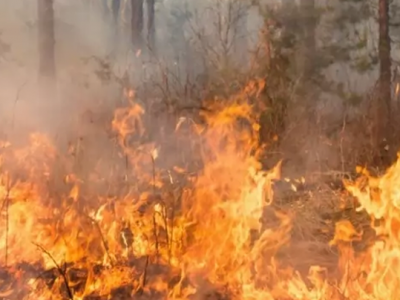Cyclones have always been devastating and in a country like India which lies in the North Indian Ocean, its most vulnerable to get hit by tropical cyclones. Cyclones are strong inward-spiraling winds that rotate around a low-pressure area. The Economic Cost of Climate Change can be seen evidently in the form of huge losses suffered by the country. As a result of Global Warming becoming the biggest concern in the World, cyclones are proving to be the biggest loss-making destructions that economies are facing everywhere. One such grievous cyclone that hit India in 2021 was CYCLONE TAUKTAE, which affected southern regions of Kerala and Karnataka and western regions of Goa, Gujarat, Lakshadweep, also Dadar, Nagar Haveli, and Daman and Die followed by Flash Floods and Heavy Rainfall. The interesting name “TAUKTAE” as given by “World Meteorological Organization” and UN Economic and Social Commission for Asia and Pacific comes from ‘Gecko’, a highly vocal lizard.
Cyclone Tauktae hit Gujarat on 14th May 2021 and continued till it made landfall on 17th May, as reported by IMD. It brushed past a trail of destruction by adversely affecting regions of Gujarat. The storm’s rushing speed of 190 kilometers per hour brought a landfall in Gujarat devastating the lives, property, and trees. It’s the Fifth most powerful cyclone ever recorded in the history of the Arabian Sea. This phenomenon was quite astonishing for India as usually the Cyclones forming over the Arabian Sea move towards the west and do not impact the Country but this time it turned out to be something different and was the second cyclone the country witnessed on the Western coast in the past 2 years. Cyclone Tauktae losses include the killing of more than 104 people in India, which forms the biggest number of deaths in the past decade due to the occurrence of cyclones in the Arabian Sea. The cyclone intensified gradually and came under the category of second “Extremely Severe Cyclone” Storm to hit Gujarat in 23 years which turned into a dangerous reality.
IMPACT ON THE LIFESTYLE AND PROPERTY
It imposed a triple impact because of the overlapping factors like the water rising with the storm surge along with the heavy rainfall and the rising sea level, these factors create a “compound impact”, as said by the climate scientist Roxy Mathew Koll of Indian Institute of Tropical Meteorology (IITM), Pune. It aggravated due to high Sea Surface Temperature over the Arabian Sea.
Amid the pandemic fretting India, Tauktae made its debut and battered lifestyles. It exacerbated the prevalent conditions of pandemics and created chaos. The cyclone served as a hurdle during the vaccination drive that was going on in many states and disrupted the health infrastructure too. For instance, Goa witnessed collapsing roof as a result of a cyclone in one of the medical colleges, allotted especially as a Covid Ward for providing medical help to people in form of providing them with oxygen cylinders. This situation also arrived in the parts of Maharashtra and Gujarat, impeding the vaccination drive.
When India was grappling with the pernicious surge within the Covid-19 cases, Tauktae acted as a catalyst within the grave state of affairs. Further, when talked about the smallholder farmers, who were already suffering to earn their livelihoods due to the strict lockdown imposed by the government amidst the pandemic, this destruction by the cyclone has conspired the impact on them and had worsened the situation. Physically, mentally, and financially, in all aspects, they had to face the crunch of the catastrophic event.
National Disaster Response Force (NDRF) and State Disaster Response Force (SDRF) were deployed to evacuate almost 1.5 lakh people from low-lying coastal areas in Gujarat. Several Villages and Houses were affected by the cyclonic winds. It also led to the disruption of power supply and damage to the infrastructure in southern regions.
REPERCUSSIONS ON THE FARM ECONOMY IN INDIA
The cyclone struck the farms of the Gujarat mango farmers on 18th may and had caused havoc by the rushing wind accompanied by the torrential rainfall for about 10 hours and created a situation of panic among the region’s residents. The high-velocity winds wiped out the mango orchards and uprooted the trees.
Approximately 70% of the unripe mangoes that were about to get harvested were destroyed by the cyclone and only 10% remained available for harvesting. This resulted in a 50% loss for the farmers in their annual average income. The changing weather conditions have always been dreadful for the farmers and have brought bad news for them.
Apart from this, Idukki, a state in Kerala featured giant-scale crop injury especially the cardamom and also the winter vegetables as an impression of Tauktae. Major acres of cardamom plantations were affected within the districts of Vandanmedu, Mali, Anyartholu, Anavilasom, and Chakkupallam. Around 30% of the reduction within the cardamom production was expected in step with the cardamom growers association.
Gujarat Government had also ordered a survey to check on the damages reported by the states after Cyclone Tauktae pulverize mango orchards, banana plantations, and coconut palms. The coconut palm growers faced massive damage in the coastal regions. Even the farmers that grow banana plantations in Kheda, Anand, Bharuch, and Bhavnagar districts have suffered heavy losses. The summer paddy in Surat and adjoining districts have been ruined.
Here comes the importance of the Risk Management Process and Predictive Analysis so that such catastrophic events are foreseen well in advance which would help the authorities and the people to have enough time to prepare for such natural calamities.
Technology has advanced a lot in every field and has excelled in various areas. Advanced models and tools are now being used for risk analysis and prediction of these calamities to a greater extent.
As explained by Pushpendra Johri, Senior VP for sustainability in RMSI that there are two aspects to consider in Cyclone Prediction. One is the tracking of cyclone and Landfall location done with the help of the Numerical Weather Prediction Model providing higher accuracy. The second one is the Prediction of the aftermath impact of the cyclone that is the wind, surge which is done by the combination of the empirical and numerical model and rainfall-induced floods, predicted using hydrological and hydraulic models. These advanced forecasts would provide help significantly to the coastal authorities for pre-planning and being ready for the emergency measures. Also, the insurance company could reckon the total amount of claim payout. A Decision Support System needs to be formed so that they can alert and inform authorities for early actions to be taken and measures for safeguarding the people and property.
CONCLUSION
Some vital cyclone risk reduction measures could have been taken to prepare for the Cyclone Tauktae like the barges would have been moved closer based on the forecast predictions as it generates alerts about the risk of detaching. Also, there is a need for enhancing the electric power and communication network like the use of tendons can reduce vibrations in towers and stacks thereby reducing the risks. But these initiatives must be taken by the Government and the public sector agencies.
Moreover, to combat multiple risks, relevant information and appropriate skills sets need to be developed for the risk assessment and its mitigation tools. Risk Management requires efficiency as well as effective action to be taken by people, so information needs to be shared among communities along with the government agencies.
India has developed a good cyclone risk assessment system, but it needs to be strengthened. Investing in a Technology-enabled early warning signal system would provide dual help by planning for both climate and health risks that would result in strengthening the economy as a whole. The real-time information provided by Geographical Information Systems (GIS) technology has a large scope to mitigate the risks and lessen the desecration of such calamities in the future.
REFERENCE
https://india.mongabay.com/2021/05/cyclone-tauktae-exposes-vulnerabilities-along-indias-west-coast/
Blog Published By: Sakshi Mishra, Student Risk Committee Member












